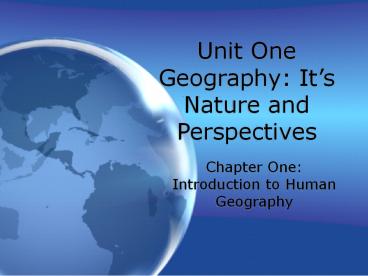Unit One Geography: It - PowerPoint PPT Presentation
Title:
Unit One Geography: It
Description:
Major Divisions of Systematic Geography: Physical Geography VS Human Geography ... Describes a place in relationship to other human and physical features. ... – PowerPoint PPT presentation
Number of Views:845
Avg rating:3.0/5.0
Title: Unit One Geography: It
1
Unit OneGeography Its Nature and Perspectives
- Chapter One Introduction to Human Geography
2
Major Divisions of Systematic Geography Physical
Geography VS Human Geography
3
The Five Themes of Geography
- Derived from the spatial perspective of
geography. - Variations amongst geographic phenomenas across
space.
4
(No Transcript)
5
LOCATION
- Answers the questions where and why.
6
Absolute Location
- The exact location of something based on latitude
and longitude A formal mathematical measurement. - Is a fixed location Does not change.
7
Relative Location
- Describes a place in relationship to other human
and physical features. - Usually this is done using a landmark of sorts.
- Are not set in stone, rather these locations
frequently change - For example Where is the ASC Residence?
- Old The 4th floor of the Jes. Res. Building.
- New Across from Marquette High on the corner of
33rd and Michigan.
8
Human-Environment Interactions
- The relationship between humans and the physical
world. - Addresses the Cultural Landscape.
- All human-induced changes that involve the
surface and the biosphere.
9
Environmental Determinism Theory (Alexander von
Humboldt and Carl Ritter)
- States that human behavior is affected by and/or
controlled/determined by the environment. - Physical environment causes social development.
- NOT A GOOD THEORY Why?
10
POSSIBILISM THEORY
- Counter-theory to ED Theory.
- States that the natural environment serves to
limit the range of choices available to a
culture. - BUT, people have the means/resources to work
around these limitations and adjust their
environments.
11
PLACE
- A specific point on the earths surface
distinguished by a particular characteristic. - Could be a cultural feature, physical processes,
landforms/geo. features.
12
PLACE Cont
- Perception of Place
- The view one creates about a specific place, even
though the person has never been there. - based on images, stories, and media, etc.
- For example Columbia.
- PASS OUT MAPS
13
(No Transcript)
14
Region
- Areas of unique characteristics.
- Way of organizing people geographically.
- Unity based off of cultural landscape.
15
Distinctive Characteristics
- The area covered (spatially).
- The location.
- The boundaries.
- visible/tangible (or not)
- Can be pre-determined.
- Also impacted by culture, economics, politics,
and physical landscape.
16
Types of Regions
- Formal Region (uniform region)
- Functional Region (nodal region)
- Vernacular Region (perceptual)
17
Overlapping Formal and Functional Regions
18
Vernacular Regions
19
(No Transcript)
20
(No Transcript)
21
MOVEMENT
- The mobility and interconnection of people,
ideas, services, and goods across the planet. - Dependent upon distances, accessibility, and
connections.
22
MOVEMENT Cont
- Diffusion
- The process of spreading something from one
place/person to another. - Types of Diffusion
- Cultural
- Expansion
- Contagious, Hierarchical, and Stimulus
- Relocation
- Acculturation
- Transculturation
23
Diffusion
24
Forces that inhibit diffusion
- Time-Distance Decay
- The longer something has to travel, the less
likely it will make it there. - Cultural Barriers
- Prevailing attitudes, traditions, or taboos.
25
Key ConceptsCore-Periphery
- Core
- U.S., Europe, Japan, Australia
- Wealthy
- Powerful
- Controls Media and Finance
- Technologically advanced
- Periphery
- Less Developed
- Poor
- Dependent upon Core countries for
- Education
- Technology
- Media
- Military Equipment
26
(No Transcript)
27
NEW TOPIC Understanding Maps
- Reference Maps
- Thematic Maps
28
Upside Down World
- http//www.flourish.org/upsidedownmap/hobodyer-lar
ge.jpg
29
Reference Maps
- Show location of places as well as geographic
features. - Show the absolute location of something.
- Map creation aided by GPS
- Global Positioning System
- Satellite system that can identify the absolute
location of a place or feature.
30
(No Transcript)
31
Thematic Layer Maps
- Are story telling maps.
- Show the degree of an attribute or movement of a
geographical phenomena. - Are qualitative (characteristic) or quantitative
(amount of). - Created Using GIS
- Geographic Information System
32
(No Transcript)
33
SCALE
- The representation of real world phenomena at a
certain level of reduction or generalization. - The ratio between the size of an area on a map
and the actual size of that same area on the
earths surface.
34
Ways To Express Scale
- Representative Fraction
- Word Statement
- Graphic Scale
35
SCALE Cont
- Large Scale
- Shows a smaller piece of earth with greater
detail. - RF is usually between 11-150,000
- Small Scale
- Shows a larger piece of earth with less detail
- This is often very inaccurate because the degree
of generalization is great.
36
SCALE Cont
- BEWARE OF THE FALLACY OF TRUTH!
- One scale may not be true at a different scale.
37
(No Transcript)
38
(No Transcript)
39
(No Transcript)































